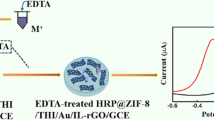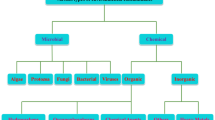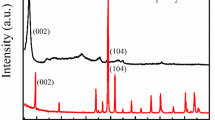Abstract
Application of malachite green (MG) and leucomalachite green (LMG) in fish farm water causes an environmental problem. This study proposes for the first time a sensitive and convenient electrochemical impedance spectroscopy (EIS) method for determining MG and LMG by a bovine serum albumin-decorated gold nanocluster (BSA-AuNC)/antibody composite film-based immunosensor. In order to improve the analytical performance, the glassy carbon electrode (GCE) was modified with 1, 4-phenylenediamine to form a stable layer, and then, BSA-AuNCs were covalently bound to the GCE. An adequate quantity of the polyclonal antibody of LMG was immobilized onto the surface of the BSA-AuNCs by the chemical reaction of EDC/NHS. The sensors can respond to the specific target based on specific covalent bonding. The experimental parameters, such as the pH, incubating concentration, and time, have been investigated and optimized. The calibration curve for LMG was linear in the range of 0.1~10.0 ng/mL with the limit of detection (LOD) 0.03 ng/mL. Furthermore, the sum of MG and LMG was detected in fish farm water by MG reduction. The recovery was between 89.7 % and 99.2 % in spiked samples. The EC sensor method was also compared with the ELISA method and validated by the LC–MS/MS method, which proves its great promise as a field instrument for the rapid monitoring of MG and LMG pollution.

1, 4-Phenylenediamine and BSA-AuNC/antibody-decorated glassy carbon electrodes have been used for the impedimetric detection of the sum of malachite green and leucomalachite green via specific immuno-binding






Similar content being viewed by others
References
Yang MC, Fang JM, Kuo TF, Wang DM, Huang YL, Liu LY, et al. Production of antibodies for selective detection of malachite green and the related triphenylmethane dyes in fish and fishpond water. J Agric Food Chem. 2007;55(22):8851–6.
Mitrowska K, Posyniak A, Zmudzki J. Determination of malachite green and leucomalachite green residues in water using liquid chromatography with visible and fluorescence detection and confirmation by tandem mass spectrometry. J Chromatogr A. 2008;1207(1–2):94–100.
Burchmore S, Wilkinson M. Proposed environmental quality standards for malachite green in water (DWE 9026). UK Department of the Environment, Transport, and the Regions Report No. 3167/2, prepared by the Water Research Centre, Marlow, Buckinghamshire, England. 1993.
Jiang Y, Chen L, Hu K, Yu W, Yang X, Lu L. Development of a fast ELISA for the specific detection of both leucomalachite green and malachite green. J Ocean Univ China. 2014;14(2):340–4.
Xing W, He L, Yang H, Sun C, Li D, Yang X, et al. Development of a sensitive and group-specific polyclonal antibody-based enzyme-linked immunosorbent assay (ELISA) for detection of malachite green and leucomalachite green in water and fish samples. J Sci Food Agric. 2009;89(13):2165–73.
Zhang Y, Yu W, Pei L, Lai K, Rasco BA, Huang Y. Rapid analysis of malachite green and leucomalachite green in fish muscles with surface-enhanced resonance Raman scattering. Food Chem. 2015;169:80–4.
Ju S, Deng J, Cheng J, Xiao N, Huang K, Hu C, et al. Determination of leucomalachite green, leucocrystal violet and their chromic forms using excitation-emission matrix fluorescence coupled with second-order calibration after dispersive liquid-liquid microextraction. Food Chem. 2015;185:479–87.
Dong JX, Xu C, Wang H, Xiao ZL, Gee SJ, Li ZF, et al. Enhanced sensitive immunoassay: noncompetitive phage anti-immune complex assay for the determination of malachite green and leucomalachite green. J Agric Food Chem. 2014;62(34):8752–8.
Privett BJ, Shin JH, Schoenfisc MH. Electrochemical sensors. Anal Chem. 2010;82(12):4723–41.
Eric B. Electrochemical sensors. Anal Chem. 2004;76(12):3285–98.
Vasudev A, Kaushik A, Bhansali S. Electrochemical immunosensor for label free epidermal growth factor receptor (EGFR) detection. Biosens Bioelectron. 2013;39(1):300–5.
Zhu C, Yang G, Li H, Du D, Lin Y. Electrochemical sensors and biosensors based on nanomaterials and nanostructures. Anal Chem. 2015;87(1):230–49.
Pejcic B, De Marco R. Impedance spectroscopy: over 35 years of electrochemical sensor optimization. Electrochim Acta. 2006;51(28):6217–29.
Hayat A, Barthelmebs L, Marty J-L. Electrochemical impedimetric immunosensor for the detection of okadaic acid in mussel sample. Sensors Actuators B Chem. 2012;171–172:810–5.
Yu L, Zhang Y, Hu C, Wu H, Yang Y, Huang C, et al. Highly sensitive electrochemical impedance spectroscopy immunosensor for the detection of AFB1 in olive oil. Food Chem. 2015;176:22–6.
Yang P, Zheng Q, Xu H, Liu J, Jin L. A highly sensitive electrochemical impedance spectroscopy immunosensor for determination of 1-pyrenebutyric acid based on the bifunctionality of Nafion/gold nanoparticles composite electrode. Chin J Chem. 2012;30(5):1155–62.
Sun X, Ma Z. Highly stable electrochemical immunosensor for carcinoembryonic antigen. Biosens Bioelectron. 2012;35(1):470–4.
Zhang Y, Li B, Yan C, Fu L. One-pot fluorescence detection of multiple analytes in homogenous solution based on noncovalent assembly of single-walled carbon nanotubes and aptamers. Biosens Bioelectron. 2011;26(8):3505–10.
Anjum SQW, Gao W, Zhao J, Hanif S, Aziz-ur-Rehman, Xu G. Fabrication of biomembrane-like films on carbon electrodes using alkanethiol and diazonium salt and their application for direct electrochemistry of myoglobin. Biosens Bioelectron. 2015;65:159–65.
Xie J, Zheng Y, Jackie YY. Protein-directed synthesis of highly fluorescent gold nanoclusters. J Am Chem Soc. 2009;131(3):888–9.
Liu H, Malhotra R, Peczuh MW, Rusling JF. Electrochemical immunosensors for antibodies to peanut allergen ara h2 using gold nanoparticle-peptide films. Anal Chem. 2010;82(13):5865–71.
Wang M, Kang H, Xu D, Wang C, Liu S, Hu X. Label-free impedimetric immunosensor for sensitive detection of fenvalerate in tea. Food Chem. 2013;141(1):84–90.
Mashazi P, Tetyana P, Vilakazi S, Nyokong T. Electrochemical impedimetric immunosensor for the detection of measles-specific IgG antibodies after measles infections. Biosens Bioelectron. 2013;49:32–8.
Chen Y, Yang Y, Tu Y. An electrochemical impedimetric immunosensor for ultrasensitive determination of ketamine hydrochloride. Sensors Actuators B Chem. 2013;183:150–6.
Ahmed A, Rushworth JV, Wright JD, Millner PA. Novel impedimetric immunosensor for detection of pathogenic bacteria Streptococcus pyogenes in human saliva. Anal Chem. 2013;85(24):12118–25.
Deng J, Li L, Yang X, Cen J, Xin S, Wei Y, et al. Determination of malachite green in water using solid phase extraction-high performance liquid chromatography with fluorescence detection. Food Sci. 2012;33(14):150–3.
Han S, Yuan Y, Hu L, Xu G. Electrochemical derivatization of carbon surface by reduction of diazonium salts in situ generated from nitro precursors in aqueous solutions and electrocatalytic ability of the modified electrode toward hydrogen peroxide. Electrochem Commun. 2010;12(12):1746–8.
Cougnon C, Gohier F, Belanger D, Mauzeroll J. In situ formation of diazonium salts from nitro precursors for scanning electrochemical microscopy patterning of surfaces. Angew Chem. 2009;48(22):4006–8.
Cougnon C, Mauzeroll J, Belanger D. Patterning of surfaces by oxidation of amine-containing compounds using scanning electrochemical microscopy. Angew Chem. 2009;48(40):7395–7.
Zhang K, Ji J, Fang X, Yan L, Liu B. Carbon nanotube/gold nanoparticle composite-coated membrane as a facile plasmon-enhanced interface for sensitive SERS sensing. Analyst. 2015;140:134–9.
Santhosh M, Chinnadayyala SR, Kakoti A, Goswami P. Selective and sensitive detection of free bilirubin in blood serum using human serum albumin stabilized gold nanoclusters as fluorometric and colorimetric probe. Biosens Bioelectron. 2014;59:370–6.
Shang L, Yang L, Seiter J, Heinle M, Brenner-Weiss G, Gerthsen D et al. Nanoparticles interacting with proteins and cells: a systematic study of protein surface charge effects. Adv Mater Interfaces. 2014;1(2).
Marradi M, Di Gianvincenzo P, Enriquez-Navas PM, Martinez-Avila OM, Chiodo F, Yuste E, et al. Gold nanoparticles coated with oligomannosides of HIV-1 glycoprotein gp120 mimic the carbohydrate epitope of antibody 2G12. J Mol Biol. 2011;410(5):798–810.
Rezaei B, Askarpour N, Ensafi AA. A novel sensitive doxorubicin impedimetric immunosensor based on a specific monoclonal antibody-gold nanoparticle-sol-gel modified electrode. Talanta. 2014;119:164–9.
Acknowledgments
This work was supported by the Natural Science Foundation of China (31371779) and the International Science and Technology Cooperation Program of China (2015DFG31890).
Author information
Authors and Affiliations
Corresponding author
Ethics declarations
All procedures performed in studies involving animals were in accordance with the ethical standards of the institution or practice at which the studies were conducted.
Conflict of interest
The authors declare that they have no competing interests.
Electronic supplementary material
Below is the link to the electronic supplementary material.
ESM 1
(PDF 455 kb)
Rights and permissions
About this article
Cite this article
Zhu, D., Li, Q., Pang, X. et al. A sensitive electrochemical impedance immunosensor for determination of malachite green and leucomalachite green in the aqueous environment. Anal Bioanal Chem 408, 5593–5600 (2016). https://doi.org/10.1007/s00216-016-9660-3
Received:
Revised:
Accepted:
Published:
Issue Date:
DOI: https://doi.org/10.1007/s00216-016-9660-3




